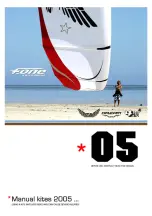
10
By applying approximately 20cm of brakes the Mantra M7 will achieve its Minimum-Sink rate; this is the
speed for best climb and is the speed to use for thermalling and ridge soaring.
Turning
To familiarize yourself with the Mantra M7 your first turns should be gradual and progressive. To make
efficient and coordinated turns, first check the airspace is clear and then lean in the direction you want to
go. The first input for directional change should be weight-shift, followed by a smooth application of the
brake until the desired bank angle is achieved. To regulate the speed and radius of the turn, coordinate
your weight shift and use the outer brake.
Active Flying
To minimize the likelihood of suffering collapses in turbulent conditions, it is essential to use active flying.
These are skills that are best learnt by playing with the glider on the ground. Flying with a small amount
of brake applied (approx. 20cm) will allow you to feel the feedback from the wing. In turbulent conditions
the internal pressure of the wing is constantly changing and by using a small amount of brake will you feel
these changes. The aim of active flying is to maintain a constant pressure through the brakes, If you feel
a reduction or loss of pressure quickly apply the brakes until you feel normal pressure again. Once you
have normal pressure, raise the hands back to the original position. Avoid flying with continuous amounts
of deep brake in rough air as you could inadvertently stall the wing - always consider your airspeed. The
brake inputs can be symmetric or asymmetric; you may have to apply both brakes or just one. These
subtle adjustments will keep the glider flying smoothly and directly above you and dramatically reduce the
likelihood of a collapse. If the glider pitches in front of you, use the brakes to slow it down. Equally, if the
glider drops behind you, release the brakes to allow it to speed up, but be ready to anticipate the following
pitch forward. The goal is to maintain the wing directly overhead with a constant level of internal pressure.
No pilot and no glider are immune to collapses however correct active flying will reduce the chances
significantly. When the conditions are turbulent, be more active and anticipate the movements of your
wing, always be aware of your altitude and do not over-react.
We strongly advise you to keep hold of your brakes at all times and to not fly in turbulent conditions.
IMPORTANT
Always keep hold of
your brakes. Do not fly
in turbulent conditions
IMPORTANT
Never initiate a turn at
minimum speed (i.e.
with full brakes on) as
you could risk entering
a spin.












































